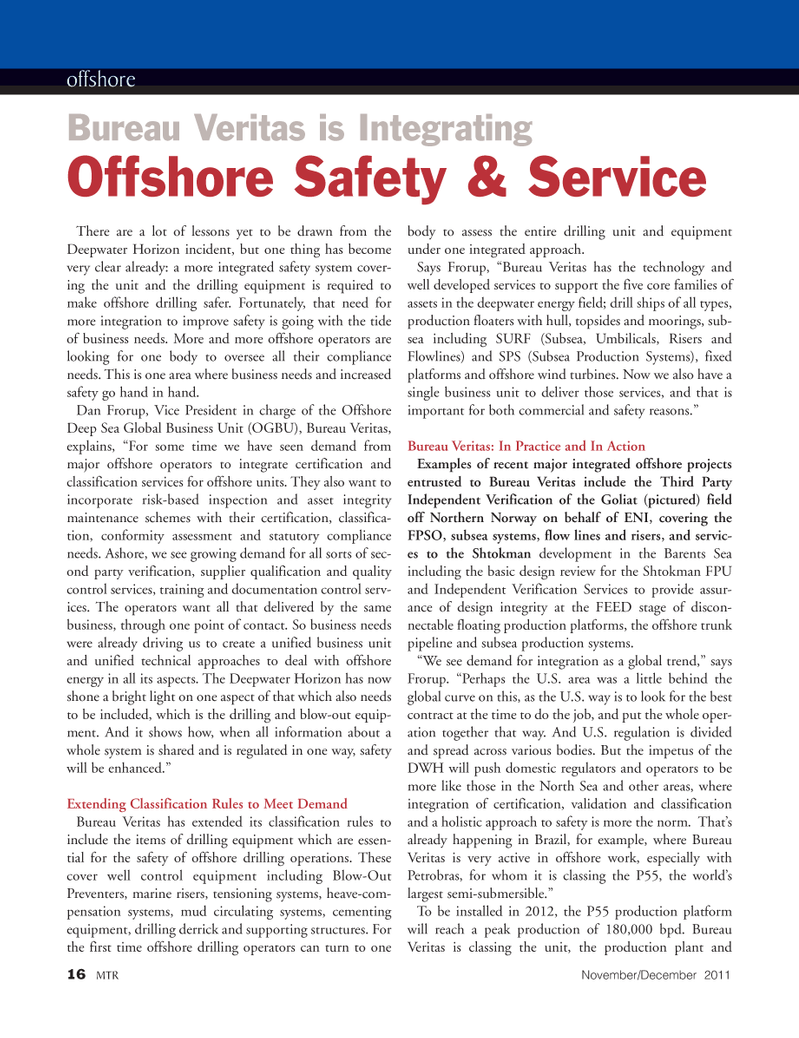
Page 16: of Marine Technology Magazine (November 2011)
FreshWater Monitoring and Sensors
Read this page in Pdf, Flash or Html5 edition of November 2011 Marine Technology Magazine
There are a lot of lessons yet to be drawn from the Deepwater Horizon incident, but one thing has become very clear already: a more integrated safety system cover- ing the unit and the drilling equipment is required to make offshore drilling safer. Fortunately, that need for more integration to improve safety is going with the tide of business needs. More and more offshore operators are looking for one body to oversee all their compliance needs. This is one area where business needs and increased safety go hand in hand.Dan Frorup, Vice President in charge of the Offshore Deep Sea Global Business Unit (OGBU), Bureau Veritas, explains, ?For some time we have seen demand from major offshore operators to integrate certification and classification services for offshore units. They also want to incorporate risk-based inspection and asset integritymaintenance schemes with their certification, classifica- tion, conformity assessment and statutory compliance needs. Ashore, we see growing demand for all sorts of sec- ond party verification, supplier qualification and quality control services, training and documentation control serv- ices. The operators want all that delivered by the same business, through one point of contact. So business needs were already driving us to create a unified business unit and unified technical approaches to deal with offshore energy in all its aspects. The Deepwater Horizon has now shone a bright light on one aspect of that which also needsto be included, which is the drilling and blow-out equip- ment. And it shows how, when all information about a whole system is shared and is regulated in one way, safety will be enhanced.?Extending Classification Rules to Meet Demand Bureau Veritas has extended its classification rules to include the items of drilling equipment which are essen-tial for the safety of offshore drilling operations. These cover well control equipment including Blow-Out Preventers, marine risers, tensioning systems, heave-com- pensation systems, mud circulating systems, cementing equipment, drilling derrick and supporting structures. For the first time offshore drilling operators can turn to one body to assess the entire drilling unit and equipment under one integrated approach. Says Frorup, ?Bureau Veritas has the technology and well developed services to support the five core families of assets in the deepwater energy field; drill ships of all types, production floaters with hull, topsides and moorings, sub- sea including SURF (Subsea, Umbilicals, Risers and Flowlines) and SPS (Subsea Production Systems), fixed platforms and offshore wind turbines. Now we also have a single business unit to deliver those services, and that is important for both commercial and safety reasons.? Bureau Veritas: In Practice and In Action Examples of recent major integrated offshore projects entrusted to Bureau Veritas include the Third Party Independent Verification of the Goliat (pictured) field off Northern Norway on behalf of ENI, covering the FPSO, subsea systems, flow lines and risers, and servic- es to the Shtokman development in the Barents Sea including the basic design review for the Shtokman FPU and Independent Verification Services to provide assur- ance of design integrity at the FEED stage of discon-nectable floating production platforms, the offshore trunk pipeline and subsea production systems. ?We see demand for integration as a global trend,? says Frorup. ?Perhaps the U.S. area was a little behind the global curve on this, as the U.S. way is to look for the best contract at the time to do the job, and put the whole oper- ation together that way. And U.S. regulation is divided and spread across various bodies. But the impetus of the DWH will push domestic regulators and operators to be more like those in the North Sea and other areas, where integration of certification, validation and classification and a holistic approach to safety is more the norm. That?s already happening in Brazil, for example, where Bureau Veritas is very active in offshore work, especially with Petrobras, for whom it is classing the P55, the world?s largest semi-submersible.?To be installed in 2012, the P55 production platform will reach a peak production of 180,000 bpd. Bureau Veritas is classing the unit, the production plant and offshore Bureau Veritas is Integrating Offshore Safety & Service 16MTRNovember/December 2011MTR#9 (1-17):MTR Layouts 11/28/2011 9:28 AM Page 16

 15
15

 17
17
